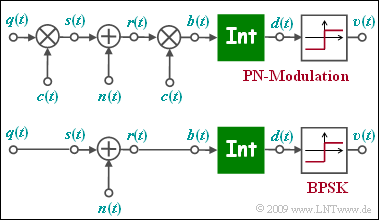Exercise 5.2Z: About PN Modulation
The upper diagram shows the equivalent circuit of $\rm PN$ modulation $($Direct-Sequence Spread Spectrum, abbreviated $\rm DS–SS)$ in the equivalent low-pass range, based on AWGN noise $n(t)$.
Shown below is the low-pass model of binary phase shift keying $\rm (BPSK)$. The low-pass transmitted signal $s(t)$ is set equal to the rectangular source signal $q(t) ∈ \{+1, –1\}$ with rectangular duration $T$ for reasons of uniformity.
The function of the integrator can be described as follows:
- $$d (\nu T) = \frac{1}{T} \cdot \hspace{-0.1cm} \int_{(\nu -1 )T }^{\nu T} \hspace{-0.3cm} b (t )\hspace{0.1cm} {\rm d}t \hspace{0.05cm}.$$
The two models differ by multiplication with the $±1$ spreading signal $c(t)$ at transmitter and receiver, where only the spreading factor $J$ is known from $c(t)$.
It has to be investigated whether the lower BPSK model can also be used for PN modulation and whether the BPSK error probability
- $$p_{\rm B} = {\rm Q} \left( \hspace{-0.05cm} \sqrt { {2 \cdot E_{\rm B}}/{N_{\rm 0}} } \hspace{0.05cm} \right )$$
is also valid for PN modulation, or how the given equation should be modified.
Notes:
- This exercise belongs to the chapter Direct-Sequence Spread Spectrum Modulation.
- For the solution of this exercise, the specification of the specific spreading sequence $($M-sequence or Walsh function$)$ is not important.
Questions
Solution
- We are dealing here with an optimal receiver.
- Without noise, the signal $b(t)$ within each bit is constantly equal to $+1$ or $-1$.
- From the given equation for the integrator
- $$d (\nu T) = \frac{1}{T} \cdot \hspace{-0.1cm} \int_{(\nu -1 )T }^{\nu T} \hspace{-0.3cm} b (t )\hspace{0.1cm} {\rm d}t $$
- it follows that $d(νT)$ can take only the values $+1$ and $-1$.
(2) Again the last solution is correct:
- In the noise– and interference-free case ⇒ $n(t) = 0$, the twofold multiplication by $c(t) ∈ \{+1, –1\}$ can be omitted,
- so that the upper model is identical to the lower model.
(3) Solution 1 is correct:
- Since both models are identical in the noise-free case, only the noise signal has to be adjusted: $n'(t) = n(t) · c(t)$.
- In contrast, the other two solutions are not applicable:
- The integration must still be done over $T = J · T_c$ and the PN modulation does not reduce the AWGN noise.
(4) The last solution is correct:
- Multiplying the AWGN noise by the high-frequency $±1$ signal $c(t)$, the product is also Gaussian and white.
- Because of ${\rm E}\big[c^2(t)\big] = 1$, the noise variance is not changed either.
- Thus, the equation $p_{\rm B} = {\rm Q} \left( \hspace{-0.05cm} \sqrt {{2 E_{\rm B}}/{N_{\rm 0}} } \hspace{0.05cm} \right )$ valid for BPSK is also applicable for PN modulation, independent of the spreading factor $J$ and the specific spreading sequence.
- Ergo: For AWGN noise, band spreading neither increases nor decreases the error probability.
